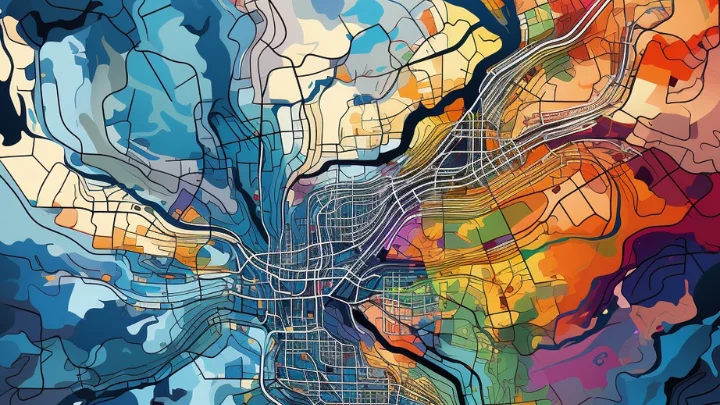This post may contain Amazon affiliate links which means, as an Amazon Associate, I may receive a small commission from purchases made through these links at no cost to you. I only recommend products I have personally used. To learn more, please see my privacy policy page.
Geographic Information Systems (GIS) are computer-based tools used for the collection, storage, analysis, and visualization of geographic data. They have applications in various fields, from resource management to research on historical events. This technology integrates spatial data with attribute data and can handle various types of information including raster and vector formats.
Key Words
- cartography
- geographic information
- geospatial data
- geovisualization
- land surveying
- metadata
- raster & vector
- remote sensing
- spatial analysis
- spatial patterns
Intrigued by how geography and technology intersect? Learn how GIS technology is not just about maps, but also a powerful tool for solving real world problems and even uncovering hidden patterns in historical events. Read on…
What is GIS?
Geographic Information Systems (GIS) have revolutionized the way we understand, analyze, and interpret the world around us. Fundamentally, a geographic information system serves as a combination of software, hardware, and data that is designed to capture, store, analyze, and present geospatial or geographic information.
In simpler terms, it’s a computer system designed to integrate, manipulate, and showcase digital data, related to positions on the Earth’s surface. The term “geographical information system” is often used interchangeably with “geographic information systems” to describe this technology that provides a way to visualize, or geovisualize, our environment.
In today’s data-centric world, GIS plays an increasingly important role. Its applications span multiple sectors, from resource management and urban planning to healthcare and emergency response systems. Whether it’s to analyze the optimal locations for new retail stores, manage natural disasters, or study climate change impacts, GIS has become an indispensable tool.
In essence, GIS technology functions as the backbone of modern spatial decision-making, helping us make sense of large datasets related to geographical locations. Its significance cannot be overstated; as the volume of data we deal with continues to grow exponentially, GIS serves as a critical tool for making efficient, informed decisions based on spatial analysis and spatial patterns.
By providing an unparalleled platform for data visualization and analysis, GIS remains a cornerstone of modern industry, governance, and scientific research. With its many applications and ever-evolving capabilities, it promises to be a defining technology of the 21st century.

Basics of Geographic Information Systems (GIS)
At its core, a Geographic Information System (GIS) is a framework for gathering, managing, and analyzing data. Interconnected with various technologies, it allows users to view and investigate information in ways that reveal relationships, patterns, and trends. The technology goes far beyond conventional cartography, transforming rows of tabular data into meaningful maps and even interactive maps and visualizations. These visualizations enable planners, analysts, researchers, and policymakers to make more informed decisions by providing a comprehensive view of a situation.
GIS integrates cartographic data, statistical information, and computer science to paint a more complete picture of spatial relationships on Earth’s surface. The system consists of several components, including GIS software, which provides the tools for analysis such as spatial querying, overlay analysis, and geostatistical measures. GIS data, another critical component, can come in various formats like raster and vector, each suited for specific types of representation. These data are stored in layers that can be analyzed separately or in conjunction to answer complex geographical questions. Whether you’re mapping population density or studying the spatial aspects of a historical event, GIS technology offers a robust set of tools for sophisticated data analysis and visualization. Let’s take a closer look.

Components of GIS
Understanding GIS also involves acquainting oneself with its key components, which can be broadly classified into two main categories: GIS data and GIS software.
GIS Data
GIS data represents the raw materials required for building a GIS system. This data falls into two main types: spatial and attribute data. Spatial data refers to the geographical information about the Earth’s features, while attribute data provides additional information about each spatial feature.
For example, a GIS data layer might show the locations of all the rivers in a region, while the attribute data could indicate the name, length, and average depth of each river
GIS Software
GIS software is a toolset that enables the user to interact with GIS data, often in a user-friendly graphical interface. This software allows users to collect, analyze, and interpret geographic information.
Software packages can range from simple mapping tools for displaying GIS data layers on a computer screen such as Google Earth Pro to intricate systems allowing for advanced spatial analysis, data manipulation, and 3D visualization such as ESRIs ArcGIS. Various programming languages can also be used to customize the software for specific needs such as Python.
In summary, a Geographic Information System (GIS) is an integrative framework that uses GIS technology to manage spatial and attribute data efficiently. Comprising essential components like GIS data and GIS software, it serves as an invaluable tool for a wide range of applications. The system offers a powerful way for people to get a geographic understanding that goes beyond just the data, opening up a new world of spatial analysis that was previously unimaginable.

More on the Types of Data in GIS
One of the most crucial elements that make Geographic Information Systems (GIS) so powerful is the variety and complexity of the data it can handle. Understanding the different types of data in GIS is essential for both GIS professionals and end-users. This section describes data in a bit more detail – such as spatial, attribute, raster, vector, and geographic as well as metadata, providing a brief overview of the key data types involved in the GIS process.
Spatial Data
This type of data refers to information that represents the physical location and shape of geometric objects. These objects can range from points (e.g., a fire hydrant), lines (e.g., a road), to polygons (e.g., a lake). Spatial data is typically stored in layers, making it easy to overlay one set of data on top of another to produce complex maps and models.
Attribute Data
While spatial data provides the ‘where,’ attribute data provides the ‘what.’ It offers additional information about each spatial feature, such as the name of a street or the type of vegetation in an area. This data is often stored in tabular data formats and can be linked to data to provide a richer, more detailed dataset.
Raster Data vs. Vector Data
Two primary formats store GIS data: raster and vector. Raster data consists of pixels (or grid cells) and is ideal for representing continuous, but not discrete, spatial phenomena like elevation or temperature. In contrast, vector data is used for more discrete entities, like roads or buildings, where the emphasis is on the exact shape and location. Vector data are more versatile in capturing complex structures but may require more computational power for analysis compared to raster data.
Geographic Data
Geographic data serves as a broad category that includes both spatial and attribute data. This type of data is essential in any GIS system as it provides the foundation on which all analyses and visualizations are built. A GIS dataset will usually include multiple layers of geographic data, each layer representing a different aspect or view of the information being studied.
To manage all these various forms of data, GIS uses specific data types, such as integers, floating-point numbers, or text, to handle different kinds of information. All these pieces of information are collectively referred to as a data set, which can then be manipulated, analyzed, and visualized through a GIS platform.
Metadata in GIS
Metadata is often considered the “data about data,” serving as a guide to the understanding, use, and management of actual data sets within Geographic Information Systems (GIS). It provides essential details such as who created the data, when and how it was last updated, its geographic extent, and the appropriate scale or resolution. Accurate metadata is indispensable for data discovery and also ensures that the data can be appropriately integrated and analyzed within the GIS software. Understanding metadata is crucial for anyone using GIS technology, as it aids in interpreting the reliability and applicability of spatial and attribute data.

Spatial Analysis and Relationships
In the realm of Geographic Information Systems (GIS), the true potential of the technology comes alive through analysis. This computational process enables users to extract or create new information from data. Spatial analysis is the cornerstone of GIS, providing the means to turn raw data into insightful results by examining the geographic patterns and relationships inherent in the data.
Spatial Analysis
Spatial analysis involves a wide range of techniques to process and analyze data. From simple queries like identifying all locations within a given radius to complex operations like overlaying climate patterns over land use maps, it offers an array of tools for understanding our world. For instance, this analysis can help policymakers understand how population density affects the spread of diseases, or how changes in land use could impact local ecosystems. By providing a geographic context to analyses, GIS users can engage in more nuanced and effective problem-solving.
Spatial Relationships
Understanding spatial relationships is key to interpreting geospatial data effectively. For instance, knowing the spatial relationship between a river and nearby agricultural fields can provide insights into water quality or flood risks. Spatial relationships can be as straightforward as identifying proximity (something is close to something else) or as complex as hierarchical or network relationships (like the nested relationship of a country to its states). These relationships offer a new dimension to the data, allowing users to examine how different spatial features interact with each other within a given geographic context.
Geospatial Data
Geospatial data serves as the raw material for all spatial analysis and understanding spatial relationships. This data encompasses a variety of spatial features and their associated attributes, usually organized in layers for easier analysis. Geospatial data can be derived from multiple sources, including satellite imagery (remote sensing), surveys, and existing maps. By analyzing this data, users can better understand the spatial location of different features, such as the distribution of natural resources or the layout of a city’s transportation network.

Data Collection and Storage in GIS
For Geographic Information Systems (GIS) to function as such an effective problem-solving tool, it requires a robust and comprehensive data backbone. Two essential stages in building this backbone are data collection and data storage. These steps ensure that the GIS system has the data it needs to perform various analyses and geovisualization.
Data Collection Methods
Remote Sensing: One of the most modern methods of data collection for geological survey is remote sensing. This technology employs satellites or high-flying aircraft to capture large-scale imagery of the Earth’s surface. Remote sensing is especially valuable for capturing data in inaccessible regions, like the middle of the ocean or deep in the Amazon rainforest.
Land Surveying: Traditional land surveying methods are still widely used, particularly for capturing data at a more localized scale. Land surveyors use various techniques to measure distances, elevations, and angles on the Earth’s surface to create highly accurate maps.
These methods may also be complemented with additional data collected from surveys, historical records, or crowd-sourced platforms to enrich the GIS data set.
Data Storage
Store Data: Once collected, data must be stored in a manner that is both accessible and secure. Storage solutions can range from local servers to cloud-based systems, depending on the scale and needs of the project.
Data Capture: GIS uses specialized techniques for capturing spatial and attribute data. Whether it’s the details of a land survey, aerial photographs or large-scale imagery from remote sensing, the captured data must be converted into a format compatible with GIS software.
Raster Formats vs. Vector Formats: GIS data is commonly stored in either a raster format or vector formats. Raster formats use pixels to represent data and are best suited for continuous types of data like elevation or temperature.
Vector formats, on the other hand, are better for storing discrete data points like the locations of buildings or roads. Each format has its own set of advantages and limitations, and the choice between the two often depends on the specific requirements of a project.
In summary, data collection and storage are integral to the success of any GIS project. Employing both modern and traditional methods for capturing data ensures a robust dataset. Once collected, this data is securely stored in specialized formats, making it ready for analysis and visualization in the GIS system.

GIS Software and Tools
As the engine that powers Geographic Information Systems, the software provides the computational muscle needed to manipulate, analyze, and visualize complex data sets. With the advent of mobile technology and internet connectivity, GIS tools have evolved considerably, becoming more accessible and interactive than ever before.
GIS Software
GIS software serves as the core component that allows users to work with spatial and attribute data. This software is designed to handle a myriad of tasks ranging from simple digital map creation to complicated cartography design to complex spatial analyses. Depending on the needs, various GIS software packages are available—ranging from open-source options like QGIS to proprietary solutions such as those provided by the Environmental Systems Research Institute (ESRI). These platforms usually operate on a computer system and display the data and analyses on a computer screen for easy interpretation.
Mobile GIS
The advent of mobile technology has revolutionized GIS by allowing real-time data collection and analysis in the field. Mobile GIS applications can be run on smartphones or tablets, making GIS tools more accessible to professionals and the public alike. For instance, forest rangers can use mobile GIS maps to update information about forest conditions in real-time, while city planners can instantly update city maps as new structures are built.
GIS software and tools have evolved to become more adaptable, user-friendly, and accessible across multiple platforms. Whether it’s robust desktop applications, versatile mobile solutions, or widely accessible web-based tools like Google Maps, GIS technology continues to make significant strides, redefining how we interact with geographic data.
GIS in Action: Google Maps
One of the most widely recognized GIS tools used by the public is Google Maps. This application offers a simplified, user-friendly interface but is backed by incredibly sophisticated GIS technology.
With Google Maps, users can view data via web browsers, obtain directions, and even contribute their own data points to paper maps. Although it might not offer the analytical capabilities of specialized GIS software, it exemplifies how GIS has become embedded in our daily lives.
Programming languages like Python and JavaScript are often employed to customize GIS applications, offering tailored solutions for specific needs. This adaptability confirms GIS as not just a static, specialized tool but as a dynamic platform that can be molded to serve various requirements.
The Samsung Galaxy Tab Active3 (paid ad) is an excellent choice for GIS professionals and hobbyists alike. This rugged tablet is designed for outdoor use and challenging conditions, making it ideal to collect and analyze data in the field.
In the context of mobile GIS, the Samsung Galaxy Tab Active3 stands out as a robust and reliable choice for fieldwork. Certified with MIL-STD-810G and IP68 standards, this rugged tablet is built to endure shocks, drops, and various outdoor elements, making it indispensable for GIS professionals working in diverse conditions. Whether you’re conducting on-site spatial analysis, updating field data, or capturing georeferenced photos and videos, this tablet’s user-friendly interface ensures that you can efficiently complete your tasks, regardless of environmental challenges. With the Galaxy Tab Active3, leveraging advanced GIS tools in the field has never been more accessible or reliable.

Applications of GIS
The versatility of Geographic Information Systems (GIS) can be observed in its wide-ranging applications across various sectors. From environmental monitoring to urban planning, GIS serves as an effective problem-solving tool that helps professionals make informed decisions. The adaptability of GIS applications is particularly evident in areas such as resource management, rural development, and through the contributions of organizations like the Environmental Systems Research Institute (ESRI).
Environmental Systems Research Institute (ESRI)
ESRI is a global leader in GIS technology, offering a suite of software and solutions that enable organizations to capture, store, manipulate, and analyze geographical data. The tools developed by ESRI are employed across a myriad of sectors, from natural resource conservation to emergency response services. ESRI’s role in promoting GIS applications substantiates the system’s value as a multifaceted tool for addressing complex issues. Go to ESRIs website to learn more and even purchase your own personal license of ArcGIS.
Resource Management
In the field of resource management, GIS is invaluable for monitoring and managing natural resources like water, minerals, and forests. For instance, GIS can assist in tracking deforestation rates, identifying potential sites for renewable energy, or determining the most effective methods for waste disposal. These applications enable more sustainable practices, ensuring that resources are used in an efficient and environmentally responsible manner.
Rural Development
When it comes to rural development, GIS has a significant role in planning and executing infrastructure projects, assessing agricultural yield, and even monitoring public health trends. In rural settings, GIS can be used to map out the distribution of resources, to evaluate land use changes, or to plan for natural disasters. Through its analytical capabilities, GIS offers localized solutions that can make a tangible difference in improving the quality of life in rural areas.
GIS has proven its worth as a versatile tool that transcends the limitations of traditional data analysis and mapping techniques. Through its extensive applications, GIS enables professionals and policymakers to tackle challenges from a holistic perspective, offering efficient, targeted solutions that address the complexities inherent in managing resources and facilitating development.

GIS in the Modern World
The ubiquity of GIS in today’s world is a testament to its evolving capabilities and expanding applications. In the modern landscape, GIS is not just a specialized tool reserved for geographers or cartographers; it has permeated multiple facets of life and work, significantly influencing scientific research, population density studies, and even creating a specialized career path for GIS professionals.
Scientific Research
Modern GIS plays an essential role in scientific research, offering tools that facilitate complex data analyses and visualizations. Researchers in fields like environmental science, epidemiology, and social sciences rely on GIS to map and analyze spatial relationships and patterns. The technology allows them to tackle complicated problems, from tracking the spread of diseases to assessing the impact of climate change, providing an indispensable tool for empirical studies.
Population Density Studies
Understanding the spatial distribution of populations is crucial for urban planning, resource allocation, and social services. GIS enables sophisticated analyses of population density, permitting policymakers to make informed decisions. For example, GIS analysis can help identify areas that are under-served by public transport or healthcare facilities, leading to more equitable distribution of resources.
Historical GIS
One of the more specialized applications of GIS technology lies in the study of historical events, including genocide and conflict. This technology offers researchers a powerful tool for analyzing the spatial dimensions of such tragic episodes. For instance, studies like Spatiality of the stages of genocide: the Armenian case investigates the geographic aspects of the Armenian Genocide to offer new perspectives into the systematic processes that underlie mass violence. These applications of GIS provide a unique understanding how geography plays a critical role in the orchestration and impact of genocide and conflict. To read the article, click here.
GIS Professionals
The growing relevance and complexity of GIS have led to the rise of a specialized field for GIS professionals. These experts are well-versed in spatial analysis, data collection, and the software tools that make GIS function. They work in a variety of sectors including government, healthcare, and private industry, using modern GIS technology to solve real-world challenges.
GIS has become an integral part of the modern world, expanding its influence beyond specialized applications into broader realms. Whether it’s in scientific research, population studies, or the everyday work of GIS professionals, the technology continues to prove its utility and adaptability in a rapidly changing landscape.

Challenges and Future Trends
As GIS technology continues to grow in utility and complexity, it faces a series of challenges and opportunities. These predominantly revolve around data analysis, the importance of geographic location, and the ever-changing conditions of the Earth’s surface.
Data Analysis
One of the major challenges in GIS is data analysis. The exponential increase in data collection, especially through remote sensing and other methods, necessitates more sophisticated analytical tools. While GIS already offers a wide array of data analysis capabilities, there is a constant need for more real-time, automated solutions that can sift through large data sets to produce actionable insights.
Earth's Surface
The dynamic nature of the Earth’s surface—affected by elements like climate change, urban development, and natural disasters—poses a continuous challenge for GIS technology. Keeping GIS data up to date requires constant monitoring and adjustment, and the technology must adapt to these changes to remain accurate and effective.
Geographic Location
The precision of geographic location in GIS is another challenge. With the increasing demand for location-based services and real-time data, the importance of accurate geographic location has never been higher. This is particularly crucial for applications like emergency services, where even a small error in location can have life-altering consequences. Future trends indicate that GIS will continue to improve its geolocation capabilities, possibly incorporating more advanced GPS and satellite technologies.
In conclusion, while GIS faces challenges related to data analysis, geographic location, and the evolving conditions of the Earth’s surface, these challenges also point towards areas of future development. Advanced analytical tools, improved geolocation technology, and adaptable systems are likely to be the focus of upcoming trends in GIS.
Wrap Up...
Geographic Information Systems (GIS) have evolved into a pivotal tool with an expansive range of applications affecting nearly every sector of modern life. From scientific research and environmental conservation to urban planning and emergency response, GIS has proven its utility as a versatile, effective problem-solving instrument. It has become much more than a specialized technology; it’s a lens through which we can understand complex spatial relationships, analyze vast sets of data, and make informed decisions that have far-reaching implications.
However, like any technology, GIS is not without its challenges. As it continues to evolve, it faces hurdles related to data analysis, geographic location accuracy, and the dynamism of the Earth’s surface. Yet, these challenges also present opportunities for future advancements, making GIS an ever adaptive and invaluable resource.
In summary, Geographic Information Systems stand as a testament to the intersection of technology, geography, and data science, serving as a cornerstone for modern decision-making and planning processes.


